Understanding Qualcomm's Snapdragon 810: Performance Preview
by Joshua Ho & Andrei Frumusanu on February 12, 2015 9:00 AM EST- Posted in
- SoCs
- Qualcomm
- Mobile
- Gobi
- Snapdragon 810
GPU Performance
Last but certainly not least, we have GPU performance. As we mentioned earlier, the Snapdragon 810 introduces Qualcomm's Adreno 430, the latest member of the Adreno 400 GPU family. Qualcomm's own performance estimates call for a 30% increase over Adreno 420, with a final GPU clock of 600MHz being identical to the Snapdragon 805's (Adreno 420) own GPU clock speed.
From an architectural standpoint Adreno continues to be something of a black box for us. Other than being a modern OpenGL ES 3.1/AEP design, we don't know too much about how the GPU is laid out, and Qualcomm's current legal battle with NVIDIA likely not helping matters. In any case, Qualcomm has indicated that Adreno 430 is not just a simple extension of Adreno 420, so we may be looking at an architectural change such as wider shader blocks.
For today's benchmarks, as we mentioned before we only had a limited amount of time with the Snapdragon 810 and had issues with BaseMark X. We've had to pare down our GPU benchmarks to just 3DMark 1.2 and GFXBench 3.0. Once we get final hardware in, we will be able to run a wider array of graphics benchmarks on Snapdragon 810.
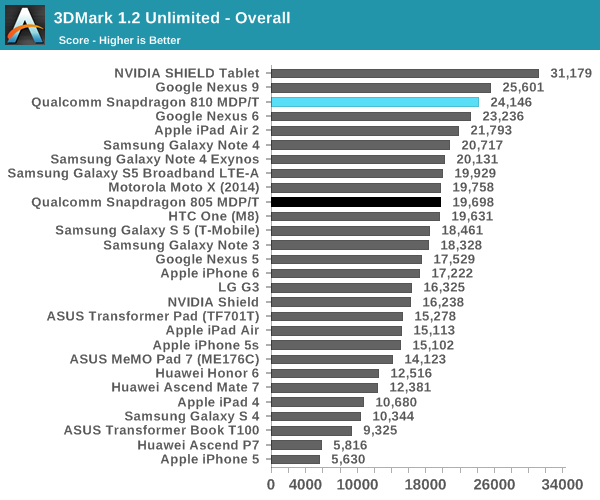
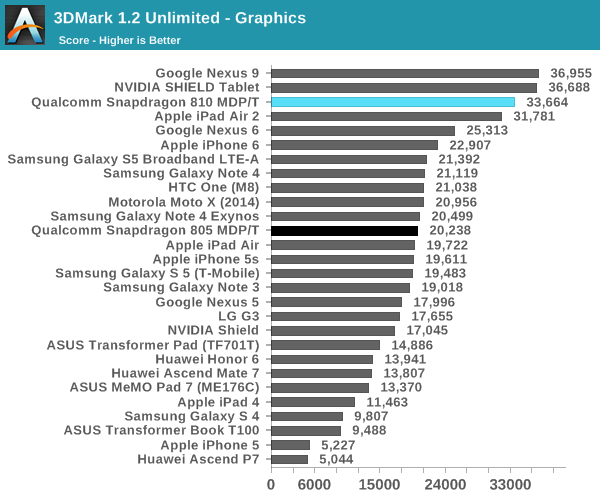
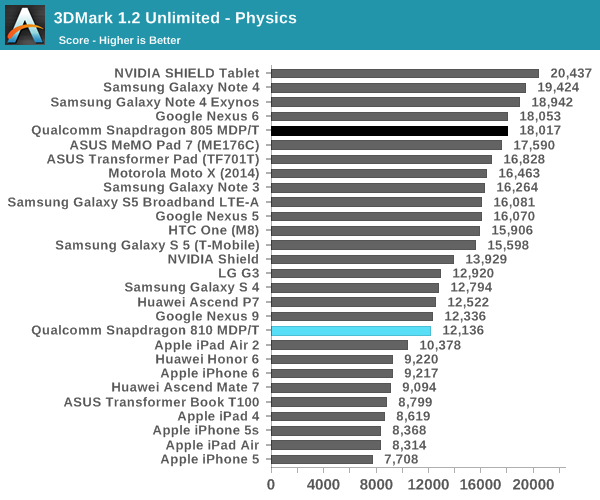
Starting off with 3DMark, compared to the Snapdragon 805 reference platform the actual graphics performance advantage is even greater than 30%, coming in at closer to 65%. However since drivers play a big role in this, a more recent 805 platform like the Nexus 6 may be a better comparison point, in which case the gains are 33%, just a hair over Qualcomm's own baseline performance estimate. We also find that Snapdragon 810 oddly struggles at physics performance here, underperforming Snapdragon 805 devices, something the Exynos 5433 didn't have trouble with. As a result overall performance is only slightly improved over the Nexus 6.
Continuing with GFXBench, we look at more pure GPU loads. One has to take note that the MDP/T employs a 4K screen resolution, and the on-screen results will likely suffer from that.

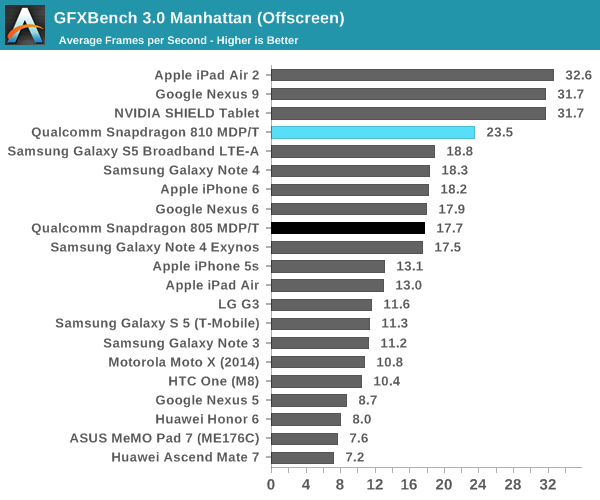
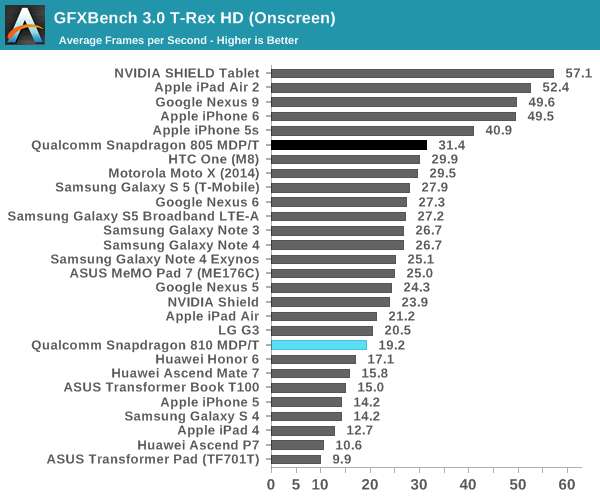
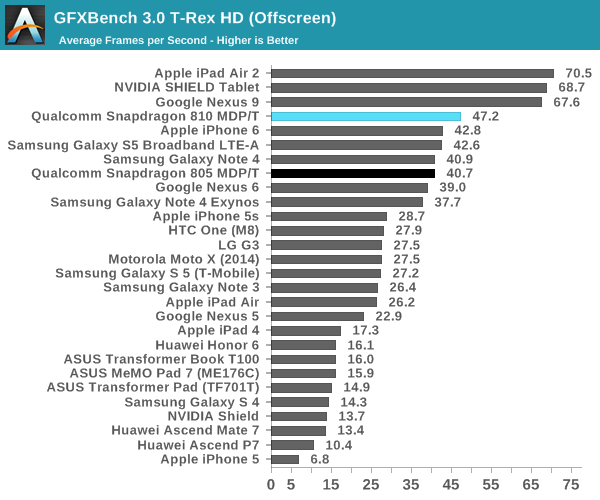
Under GFXBench 3.0's full rendering tests of Manhattan and T-Rex, the Snapdragon 810 continues to show considerable performance gains over the Snapdragon 805. Ignoring the onscreen results for now since the Snapdragon 810 reference platform runs at such a high resolution, offscreen results show the 810 outperforming the 805 by 33% in Manhattan and 16% in T-Rex. The former is again well in-line with Qualcomm's performance estimate, wile the older T-Rex benchmark doesn't show the same gains, possibly indicating that Adreno 430's biggest gains are going to come from shader-bound scenarios.
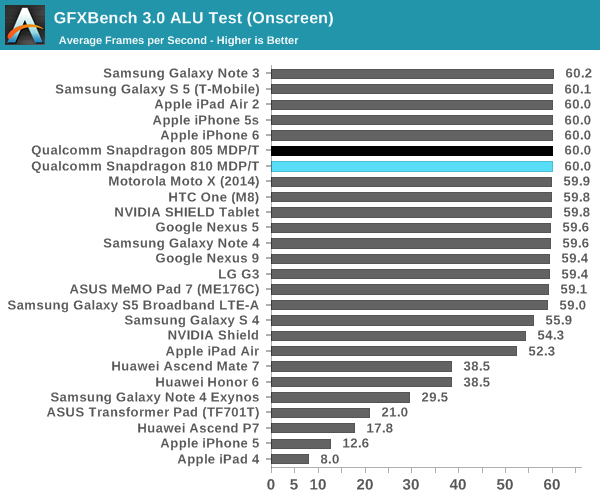
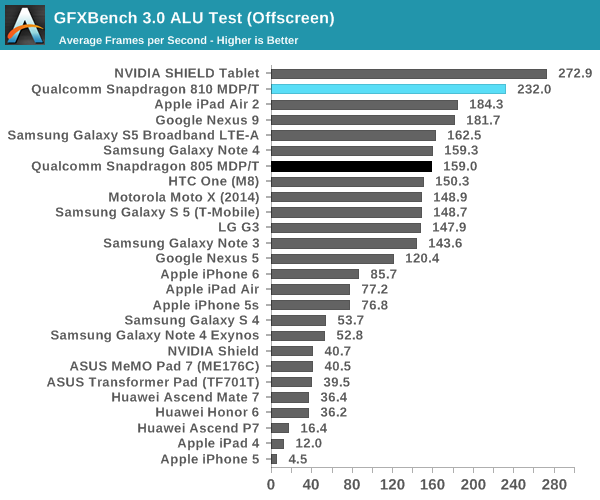

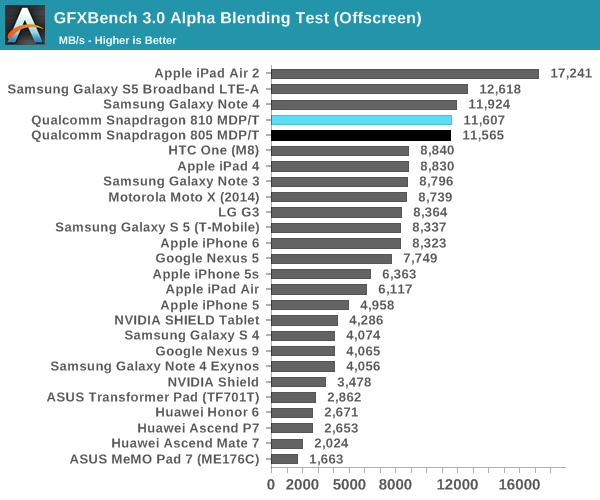
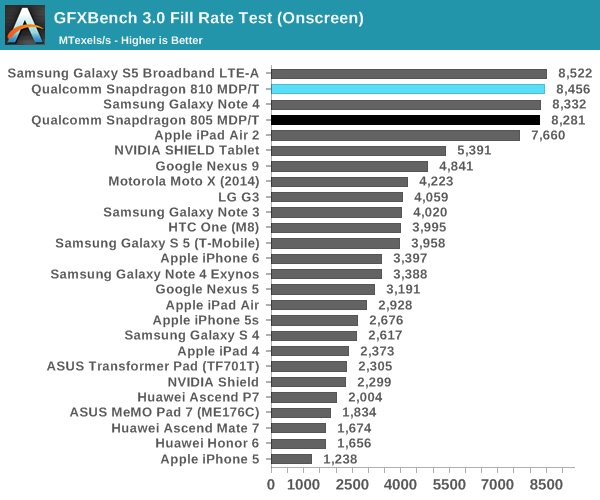
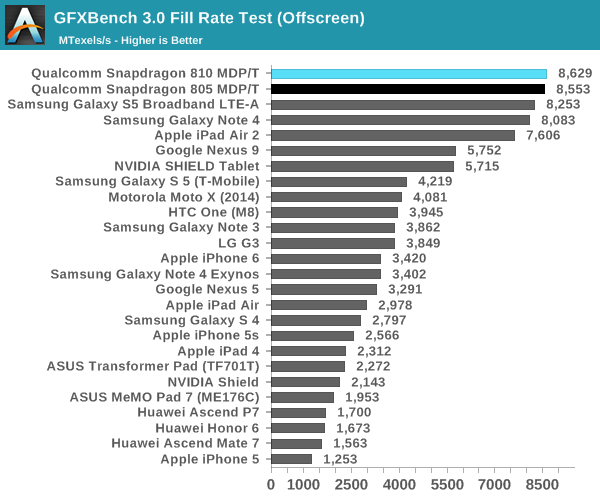
Meanwhile GFXBench's synthetic tests continue to put Adreno 430 and the Snapdragon 810 in a good light. ALU performance in particular is showing very large gains - 46% better than the Snapdragon 805 and Adreno 420 - while our blending and fillrate tests show almost no gain over Snapdragon 805. This adds further credence to our theory that Qualcomm has widened or otherwise improved Adreno's shader blocks for 430, as other elements of the GPU are not showing significant performance changes.
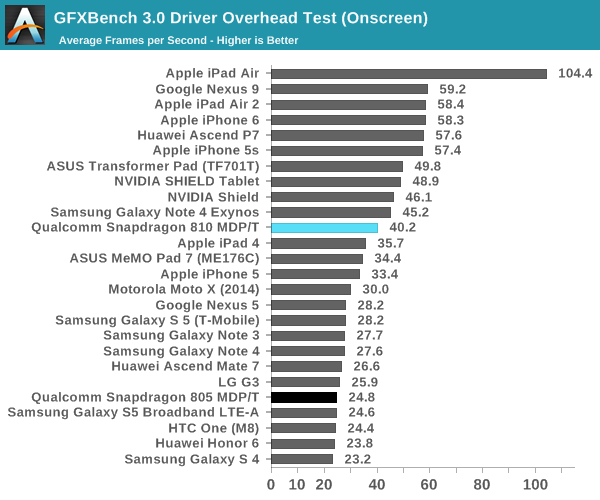
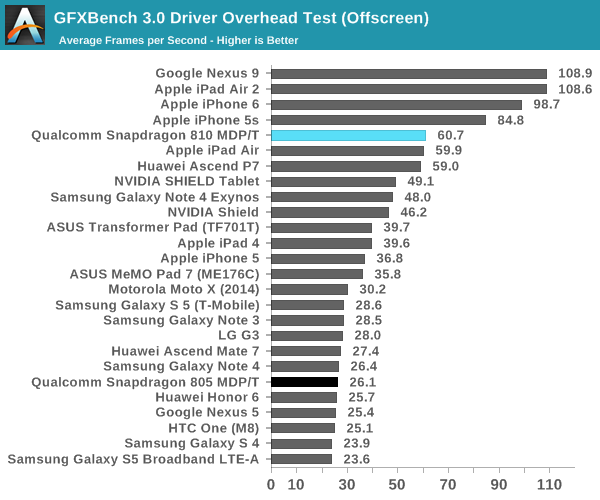
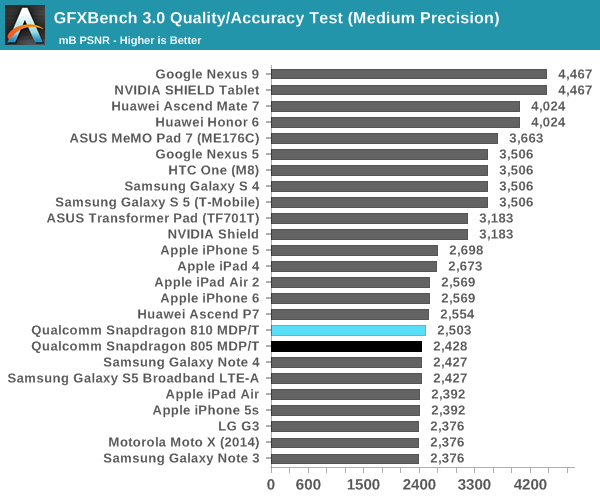

Finally, GFXBench's driver overhead and accuracy tests are more or less what we would expect for Snapdragon 810. In the case of driver overhead, a combination of newer drivers and a much faster CPU have reduced the CPU cost of driver overhead. Meanwhile with the underlying GPU architecture being unchanged, there are no material changes to quality/accuracy.
Overall then the performance gains for the Adreno 430 and Snapdragon 810 seem to be almost exclusively focused on shader performance, but in those cases where rendering workloads are shader bound, Qualcomm's 30% estimate is on the mark. Real-word performance gains meanwhile are going to depend on the nature of the workload; games and applications that are similarly shader-bound should see good performance gains, while anything that's bottlenecked by pixel throughput, texturing, or front-end performance will see much smaller gains. Thankfully for Qualcomm most high-end workloads are indeed shader bound, and this is especially the case when pushing high resolutions, as Qualcomm is trying to do with their 4K initiative for Snapdragon 810. However in the case of 4K, while Adreno 430 offers improved performance it's still slow enough that it's going to struggle to render any kind of decently complex content at that resolution.
As for Adreno 430 versus the competition, Qualcomm has narrowed much of the gap between themselves and NVIDIA/Apple, but they haven't closed it. Apple's Imagination GX6850 and NVIDIA's K1 GPUs continue to hold a performance advantage, particularly in GFXBench's Manhattan and T-Rex full rendering tests. Both Apple and NVIDIA invested significant die space in graphics, and while we don't know how much Qualcomm has invested in Adreno 430 with Snapdragon 810, it's safe to say right now that they would need to invest even more if they want to beat the graphics performance of NVIDIA and Apple's tablet SoCs.










119 Comments
View All Comments
PC Perv - Thursday, February 12, 2015 - link
Did review state on what OS the benchmarks were run? KitKat, Lollipop, 64-bit/32-bit, etc.? Sorry if I missed it.Gigaplex - Thursday, February 12, 2015 - link
Why go through all that detail on how their software stack for big.LITTLE improves over stock ARM, without testing to see if it works? The Exynos article the other day showed that big.LITTLE flat out didn't work, performing worse than parking on little cores but consuming more energy. Does Qualcomms one actually improve things here?bigstrudel - Thursday, February 12, 2015 - link
I'm beyond skeptical of 810's performance under actual thermal constraints like inside a flagship smartphone.PC Perv - Thursday, February 12, 2015 - link
I am not sure how useful those system-level benches (Basemark, 3DMark) are to compare different platforms. On same platform (OS), I can see the value.HisDivineOrder - Thursday, February 12, 2015 - link
Given all the press runs (here, PCper) Qualcomm are doing, the loss of that Samsung contract must have REALLY got someone's knickers in a twist.blzd - Thursday, February 12, 2015 - link
Good article. Thanks for including some S800 devices in some of the device comparisons, more of that (older SoC for comparison) please if you can.tuxRoller - Thursday, February 12, 2015 - link
I'll say this once again: email Rob Clark of red hat. He's been working on a clean-room implementation of adreno (https://github.com/freedreno/freedreno) for a few years and has gotten quite far (gl 2.1/gl|es 2.0, iirc).He's a super nice guy, and given that Qualcomm has been contributing, a bit, to his project he may be loathe to harm the relationship, but, if nothing else, you can read through his repo to understand the arch.
aryonoco - Thursday, February 12, 2015 - link
Fantastic preview, thanks guys, it's been great at AT over the last couple of weeks!Just a note, in future and especially when reviewing shipping devices, could you pay some attention to the 2-year upgrade performance improvement as well? Most people (in the developed world at least) seem to be on 2-year upgrade cycles, and so it makes sense to compare the current generation to the phone that's in their hand. AT does this for desktop/laptop CPUs and GPUs (for example informing people that if you already have Ivy Bridge, there's not much performance to be gained by Haswell etc) so it would be great it if that coverage extends to mobile platforms as well (for example comparing SD810 with SD600 and the level of improvement one might expect between them).
wyewye - Friday, February 13, 2015 - link
Why no Wifi tests?You say it supports MU-MIMO and 801.22ad, but anywhere else I read only "ac" and MU-MIMO is supported.
PC Perv - Friday, February 13, 2015 - link
Page 6, after the Geekbench floating-point chart, you said:"In this case Snapdragon 810 performance is relatively close to Exynos 5433 performance even though it has the advantage of running in AArch64 mode, which should give the FP numbers a boost over the Exynos. This is likely an isolated case where the Krait architecture and Snapdragon 805's high clock speed play to its favor."
And I have no idea what you are saying. I do not want to sound rude, but this kind of writing is what I saw from previous articles written by Mr. Ho (and Mr. Chester).